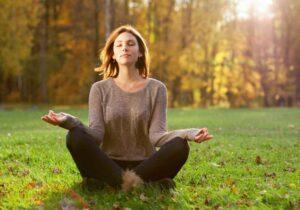Unlocking Serenity: The Bridge Pose (Setu Bandhasana)
Finding quiet moments in the busy pace of modern life often seems like a distant dream. However, the Setu Bandhasana, also known as the Bridge Pose, is the bridge that leads from turmoil to tranquility. This revitalizing yoga pose soothes the mind and strengthens the body, providing a haven of quiet amidst the chaos of daily life.
Steps to Perform Bridge Pose (Setu Bandhasana)
- Prepare Your Space: Take a comfortable position on a yoga mat by lying down on your back. Make sure that nothing is in your way.
- Bend Your Knees: As you maintain your feet level on the mat and hip-width apart, bend your knees to get your heels as close to your sitting bones as possible.
- Ground Yourself: firmly press your palms into the mat next to your hips while pointing your fingers in the direction of your shoulders. Your posture will become more stable as a result.
- Engage Your Core: Firmly press your feet and arms into the mat to raise your hips towards the ceiling as you inhale. Do not put too much pressure on your thighs as they approach one another.
- Create the Bridge: Continue raising your hips until your thighs are parallel to the ground and your torso takes on the shape of a bridge. The weight of your body should be equally supported by your arms, shoulders, and feet.
- Open Your Chest: Roll your shoulders under you to bring your shoulder blades closer together, opening your chest. This will widen the space around your heart and open up your chest.
- Lengthen Your Tailbone: To avoid putting strain on your lower back, keep your tailbone gently tucked in towards your pubic bone. An excellent way to engage the core muscles is to lengthen the tailbone.
- Hold and Breathe: Hold the pose for 30 to 1 minute, breathing deeply and steadily the entire time.
- Release with Care: To release, exhale, and gently return your hips, vertebra by vertebra, to the mat. Permit your back to revert to its neutral posture.
- Rest and Reflect: After releasing the pose, rest in Savasana (Corpse Pose) for a time and notice your body’s feelings as well as your mental state.
Benefits of Bridge Pose (Setu Bandhasana)
- Strengthens the Back: Setu Bandhasana focuses on the back’s muscles, which include the spine, to help tone and strengthen them.
- Improves Posture: Consistently performing this pose helps to rectify rounded shoulders and offsets the adverse effects of extended sitting, which enhances posture in general.
- Stretches the Chest: This position opens the chest, which stretches the pectoral muscles and releases tension in the shoulders and chest.
- Relieves Stress and Anxiety: By gently inverting the posture, you can promote relaxation and mental clarity while also lowering tension and anxiety by calming the nervous system.
- Stimulates the Thyroid Gland: Setu Bandhasana stimulates the thyroid gland, which helps to maintain hormonal balance and regulate metabolism.
- Improves Digestion: The pose’s little abdominal compression encourages digestion and may help with digestive problems.
Precautions and Contraindications of Bridge Pose (Setu Bandhasana)
- Avoid Injury: People who have back or neck pain should either refrain from doing Setu Bandhasana or only do it under the supervision of a certified yoga instructor.
- Pregnancy: When attempting this position, expectant mothers should use caution. It is best to refrain from overdoing it and to practice under the supervision of a prenatal yoga instructor.
- High Blood Pressure: Because the inversion may alter blood pressure levels, practice with support under your sacrum or refrain from it entirely if you have high blood pressure.
- Recent Surgery: Until fully healed, people who have recently had surgery, especially on the shoulders, hips, or spine, should avoid this pose.
- Listen to Your Body: When you feel pain, discomfort, or lightheadedness in the pose, release it gently and return to a neutral position. Never ignore your body’s signals, and adjust the stance as necessary.
Read More: Learn Yoga in Rishikesh
Adding Setu Bandhasana (bridge pose) to your daily yoga practice can take you on a revolutionary path toward mental clarity, emotional equilibrium, and physical strength. Accept the transition point between effort and relaxation, and let this pose’s tranquility permeate every area of your life.
Learn to know more about yoga poses so you can join yoga teacher training in india and 200 hour yoga teacher training in rishikesh and yin yoga teacher training in rishikesh




